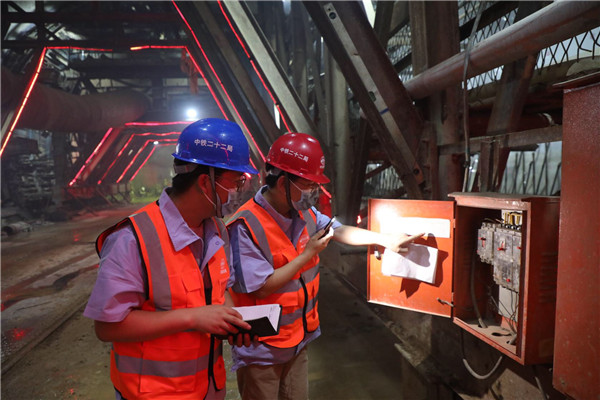

The Shangge village tunnel, the last section of the Yinchuan-Xi’an high-speed railway, was excavated on June 27, marking the completion of the main part of the railway.

An aerial photo shows the entrance of the Shangge village tunnel. (Photo/cyol.com)
The 6.78 km tunnel runs through Dongzhiyuan, the world’s largest loess tableland several hundred meters thick, with subsurface runoff, according to Wei Shaogang, general manager of the project department of China Railway 22nd Bureau Group, the constructor.
The wet loess zone in Dongzhiyuan is rare both at home and abroad. The complex geological situation has brought huge difficulties to the construction of the high-speed railway.
“The loess of the tunnel exhibits a high moisture content of 33 percent, so it is extremely easy for the tunnel to become deformed, causing collapse during construction,” said Wei.

Technicians conduct a safety check the Shangge village tunnel. (Photo/cyol.com)
However, the construction team overcame the world-level geological challenges, finding creative ways to continue construction of the tunnel.
The 618 km high-speed railway, with a design speed of 250 km per hour, is expected to begin service by the end of this year.
The high-speed railway will reduce travel time between Yinchuan in northwest China’s Ningxia Hui Autonomous Region and Xi’an in northwest China’s Shaanxi province to around three hours from the current 14 hours.

 Award-winning photos show poverty reduction achievements in NE China's Jilin province
Award-winning photos show poverty reduction achievements in NE China's Jilin province People dance to greet advent of New Year in Ameiqituo Town, Guizhou
People dance to greet advent of New Year in Ameiqituo Town, Guizhou Fire brigade in Shanghai holds group wedding
Fire brigade in Shanghai holds group wedding Tourists enjoy ice sculptures in Datan Town, north China
Tourists enjoy ice sculptures in Datan Town, north China Sunset scenery of Dayan Pagoda in Xi'an
Sunset scenery of Dayan Pagoda in Xi'an Tourists have fun at scenic spot in Nanlong Town, NW China
Tourists have fun at scenic spot in Nanlong Town, NW China Harbin attracts tourists by making best use of ice in winter
Harbin attracts tourists by making best use of ice in winter In pics: FIS Alpine Ski Women's World Cup Slalom
In pics: FIS Alpine Ski Women's World Cup Slalom Black-necked cranes rest at reservoir in Lhunzhub County, Lhasa
Black-necked cranes rest at reservoir in Lhunzhub County, Lhasa China's FAST telescope will be available to foreign scientists in April
China's FAST telescope will be available to foreign scientists in April